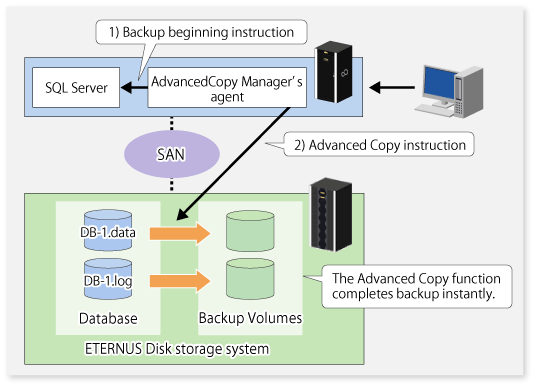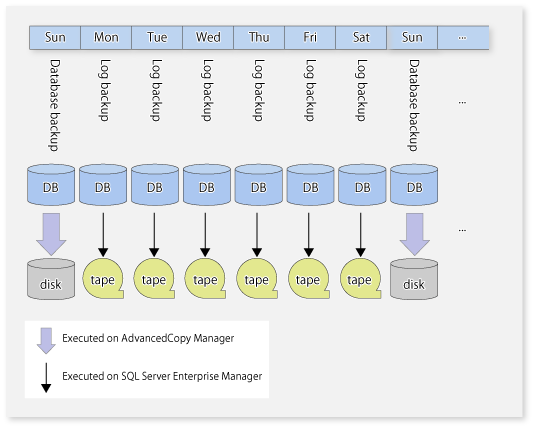An SQL Server database consists of the following physical files (ie, database files):
Primary data file (one file is required per database)
Secondary data files (there may be none, one or more than one)
Transaction log files (at least one file is required per database)
Backing up all database files is called "database backup" or "full backup".
Backing up only the log files is called "log backup"
The SQL Server backup execution command performs the database backup at high speed, and performs the following tasks:
Copies the database files (the primary data file, secondary data files, and transaction log files) to the backup volumes
Executes the data copy instantly with the Advanced Copy function, without utilizing server CPUs
Generates an online backup by cooperating with the VDI (Virtual Device Interface) mechanism of SQL Server
Figure 10.1 Backup Function Overview

In the backup of SQL Server, generally both the "database backup" and the "log backup" are performed, although not necessarily with the same frequency.
The following figure shows an example of backup operation that combines the database backup and the log backup using SQL Server. In this example, it is assumed that the operation cycle is one week, that the database backup is performed on Sundays, and that the log backup is performed on weekdays:
Figure 10.2 Example of backup operation

AdvancedCopy Manager provides the "database backup" function. Therefore, backup and restore (i.e., recovery) of a transaction log should be performed by SQL Server's Enterprise Manager and Transact-SQL, etc.
The databases which can be backed up with AdvancedCopy Manager are only user databases, and so system databases (i.e., master, msdb, model and distribution) cannot be backed up with AdvancedCopy Manager. Backup of the system databases should be performed with SQL Server.
Database type | Backup method | ||
|---|---|---|---|
SQL Server | AdvancedCopy Manager | ||
System Databases | Provided | Not provided | |
User Databases | Database backup | Provided | Provided |
Log backup | Provided | Not provided | |
Note
In this chapter, the term "database restore" refers to reloading a database image and status at the time of a specified database backup. In contrast, the term "database recovery" refers to applying logs to a database on which the database restore has been performed, in order to restore the database to a specific point or to the latest point after the database backup.